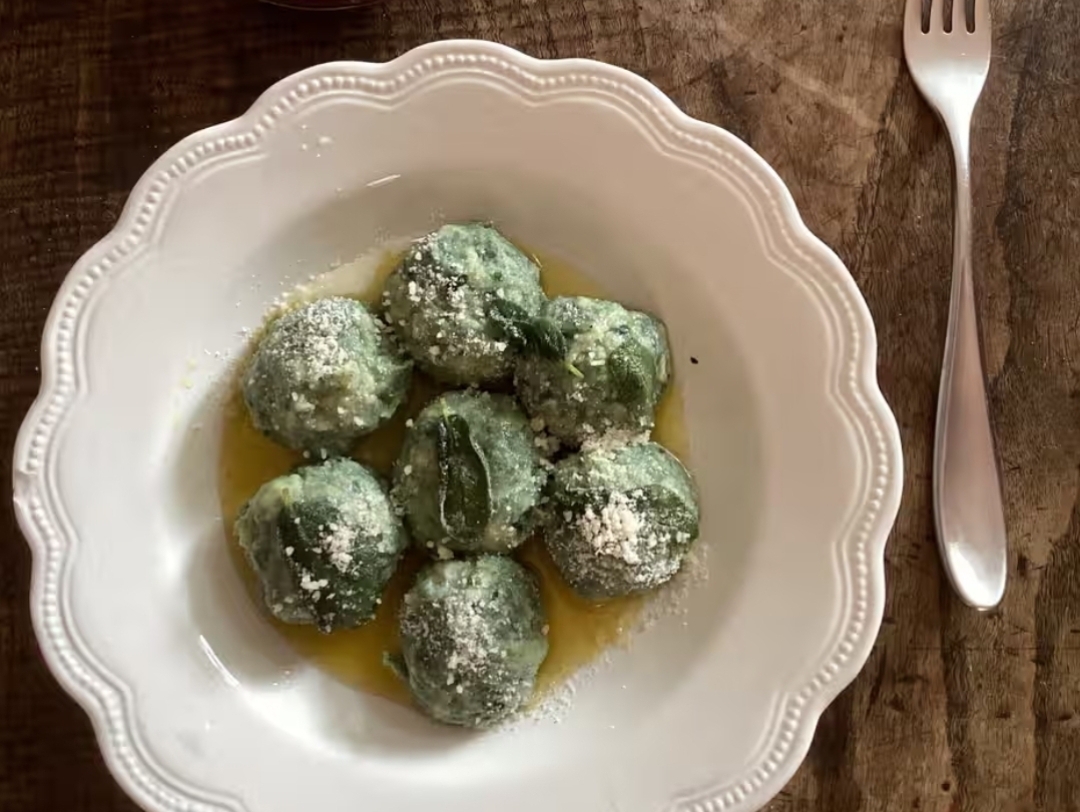A kitchen in Rome: Rachel Roddy’s recipe for spinach and ricotta gnudi

That said, my gnudi are well formed, ever since I learned an entertaining and satisfying technique (I wish I could remember who to thank for this): you put a walnut-sized lump of the spinach-speckled gnudi mixture into a small bowl along with a little semolina (or plain) flour and move the bowl in a circle, so the cheese mixture rolls around like a ball bearing in a slot machine and eventually turns into a satisfying oval. Another way of shaping is simply by rolling the balls between floured hands, or the two-teaspoon method, which involves turning and smoothing each side until it forms a neat lump, then dusting it in flour.

In much the same way that there are differing opinions about adding an egg to potato gnocchi, there are differing strong opinions about adding any flour to the ricotta and spinach mixture for gnudi. Some say the flour ruins the lightness of the gnudi and makes them gummy. Others – and I am in this group – think a scant tablespoon, plus the flour used to shape them, is barely noticeable, and helps the gnudi stay together better while they boil. For a first attempt, I suggest adding it and then, once you have got a feel for the mixture and the process, trying without.
For this “undressed” pasta, a well-dressed green salad of little gem lettuce, baby spinach and thyme is a great companion.
Spinach and ricotta gnudi
Prep 15 min
Cook 5 min
Serves 4
300g fresh spinach
250g ricotta
1 egg
60g parmesan and/or pecorino, grated, plus extra to serve
Freshly grated nutmeg
Salt
75g unsalted butter
2 tbsp plain flour, plus extra for shaping
A handful of sage leaves
Wash the spinach, lift it, with any residual water still clinging to the leaves, into a pan on a low heat and cook, stirring, until it wilts completely. Tip into a colander, top with a small plate, then press down hard to eliminate absolutely all of the water. Chop the spinach roughly.
In a bowl, mix the spinach, ricotta, lightly beaten egg, cheese, a grating of nutmeg and salt, then add the flour and mix well – the mixture should be slightly sticky, but also close to a soft dough in consistency.
To shape the gnudi, put a few tablespoons of plain flour in a small bowl. Using a teaspoon, put a walnut-sized blob of the gnudi mixture in the bowl, then rock and roll the bowl until the mixture forms a ball. If you like, elongate the ball a little, or fork it gently on one side, so it catches more melted butter later, then rest on a lightly floured tea towel while you shape the rest of the gnudi.
Fill a large, wide pan (or a wok) with water, bring it to a boil and add salt. The gnudi will take only a minute or so to boil – the water should be shaking rather than rolling. Prepare a large platter, have a slotted spoon at the ready and, in a second pan, melt the butter and sage leaves until the butter foams gently.
Carefully gather up the edges of the tea towel (two sets of hands would be useful here), move it over the pot of boiling water, then tip all the gnudi into the pan. As soon at they bob to the surface, use the slotted spoon to lift them out – shake the spoon to get rid of excess water – and on to the platter. Pour over the butter and serve immediately, passing round more grated parmesan or pecorino for those who want it.
-
Discover Rachel’s recipes and many more from your favourite cooks in the new Guardian Feast app, with smart features to make every day cooking easier and more fun





